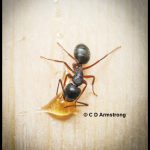Carpenter Ants
Carpenter Ants (genus Camponotus) are large ants and are so named because of their habit of excavating, tunneling and living in wood, both indoors and outdoors. Wet or rotting wood is particularly inviting and enables easy tunneling. Always check firewood for these ants before bringing it indoors. In Maine we have primarily the “New York carpenter ant” and the “Eastern black carpenter ant.” Their habits and sizes are similar, but the eastern black carpenter ant is by far the more common of the two. Carpenter ants are one of the larger ants in Maine, but there is also a very small species of carpenter ant in Maine called the “smaller carpenter ant” (Camponotus nearcticus) whose workers are only about 5 mm in length (see photos below). Nests of C. nearcticus are reported to be small as well, comprising only a few hundred individuals, but the species is nonetheless still considered a household pest.
The forest is the carpenter ant’s natural habitat. Any wet, rotten wood attracts a new queen. Carpenter ants infest live, dead or fallen trees wherever there is some rot and moisture. In nature, they play an important role in recycling wood, but when they attack buildings they are destructive. The closer a forest with rotten logs is to homes or buildings, the higher the risk is of a carpenter ant infestation.
- Carpenter Ants (workers) (one of the workers is feeding on a drop of honey)
- Eastern Black Carpenter Ant (worker) feeding on a drop of honey (Camponotus pennsylvanicus) (central Maine; 4/8/2009)
- Eastern Black Carpenter Ant (worker) (Camponotus pennsylvanicus) (central Maine; 6/13/2009)
- Carpenter Ant (Winged Queen)
- Carpenter Ant (Winged Queen)
- Carpenter Ant (Winged Queen)
- Carpenter Ant (Winged Queen)
-
Carpenter Ant Queen
(wingless stage — they shed their wings after mating)
- Queen Carpenter Ant (wingless stage)
- male Carpenter Ants (males have wings for the purpose of nuptial flights with winged queens)
- A male Carpenter Ant
- A male Carpenter Ant (central Maine; 5/29/2015)
- Smaller Carpenter Ant (worker; 5 mm in length) (Camponotus nearcticus) (Stetson, ME; 4/11/2021)
- Smaller Carpenter Ant feeding on a piece of cereal (worker) (Camponotus nearcticus) (Stetson, ME; 4/11/2021) (specimen was found crawling indoors on a shower wall)
- Smaller Carpenter Ant (Camponotus nearcticus) (closer view of the adjacent image)
Additional Information and Photos:
- Carpenter Ants (our UMaine Extension Published Fact Sheet)
- Carpenter Ants (Penn State Extension)
- Carpenter Ants [pdf] (Cornell)
- Biology and Control of Carpenter Ants (NC State Extension)
- Species found in Maine:
- Eastern Black Carpenter Ant (Camponotus pennsylvanicus) (BugGuide.net)
- New York Carpenter Ant (Camponotus novaeboracensis) (BugGuide.net)
- Smaller Carpenter Ant (Camponotus nearcticus) (BugGuide.net)
- Hercules Carpenter Ant (Camponotus herculean) (BugGuide.net)
- Ferruginous Carpenter Ant (Camponotus chromaiodes – formerly called the Red Carpenter Ant; its range is southern New England) (BugGuide.net)
back to Ants















